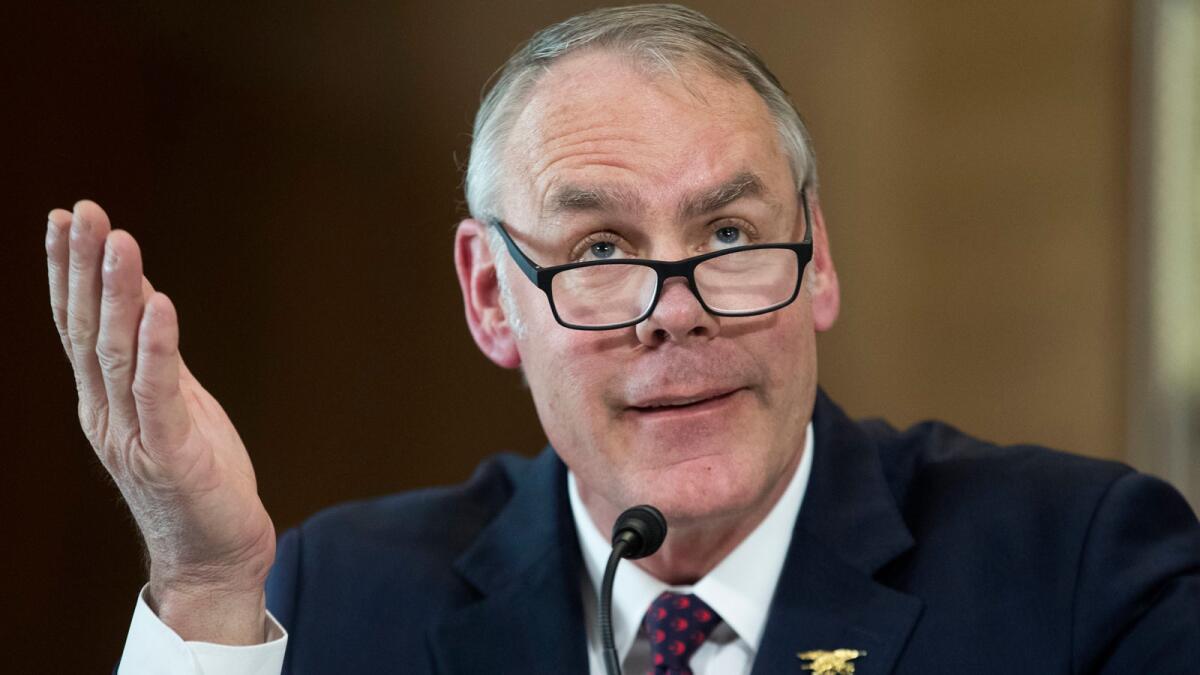Interior Secretary Ryan Zinke, under a cloud of scandal, is forced out

Interior Secretary Ryan Zinke, who endeared himself to President Trump but was caught up in scandals and infuriated environmental activists, will be departing his post by the end of the year in the latest shake-up of the president’s Cabinet.
“Secretary of the Interior @RyanZinke will be leaving the Administration at the end of the year after having served for a period of almost two years,” Trump wrote on Twitter on Saturday morning. “Ryan has accomplished much during his tenure and I want to thank him for his service to our Nation.”
There are a number of potential Republicans in the running to follow Zinke as leader of the sprawling department that manages the nation’s natural resources, from national parks to offshore oil drilling. Among the candidates frequently mentioned is David Bernhardt, a former oil and gas lobbyist who has been Zinke’s second-in-command.
The most notable firings and resignations in the Trump administration »
As deputy secretary, Bernhardt, a veteran Washington insider, has run day-to-day operations while Zinke, a folksy outsider, served as the controversial public face of a department with 70,000 employees and a $12-billion budget. Zinke, a Navy SEAL before he entered politics, came to the Interior Department after representing Montana in Congress for a single term.
Zinke famously rode a Park Police horse several blocks to his first day of work as secretary in March 2017, and donned a Boy Scout uniform when he accompanied Trump to the National Scout Jamboree that summer.
But Zinke’s swagger did not offset his legal problems and the headaches he created for the White House.
The resignation is the latest change in a broader year-end shake-up. The administration is seeking to turn the page on a tumultuous first two years that ended with sweeping midterm election losses. Already under pressure from expansive federal investigations surrounding Trump’s political and business activities, the White House must now contend with a Democratic House with subpoena power.
Trump, facing a thicket of personnel issues, forced former Atty. Gen. Jeff Sessions to resign the day after the November election.
For weeks, he fed speculation about Chief of Staff John F. Kelly’s uncertain fate before telling reporters last Saturday that Kelly was leaving at year’s end. Trump finally announced Friday that Office of Management and Budget Director Mick Mulvaney would take on the job indefinitely, serving as “acting” chief of staff, but without any plans for a successor. That brought an end to a six-day stretch during which two of Trump’s top choices to replace Kelly backed out at the last minute.
Kelly’s exit is expected to eventually precipitate the departure of Homeland Security Secretary Kirstjen Nielsen, a close Kelly ally who has clashed with the president.
The wave of departures comes after the administration already shattered past records for turnover. It threatens to bog down Trump’s agenda on Capitol Hill as focus shifts to all the confirmation hearings.
Zinke, 57, battled more than a dozen ethics probes related to his leadership at the Interior Department, and especially his alleged misuse of charter aircraft. Several probes have been closed — some because he was cleared, others due to lack of cooperation.
But an inspector general’s investigation into whether Zinke personally benefited from a Montana development deal linked to energy giant Halliburton has been referred to the Department of Justice and could result in criminal charges. He has denied any wrongdoing.
The case focuses on whether Zinke improperly spent taxpayer dollars to meet with Halliburton’s chairman, David Lesar, to discuss a land deal in Zinke’s hometown of Whitefish, Mont. The deal involved a charitable foundation that Zinke had established and is run by his wife, Lolita.
Zinke apparently tried to replace the inspector general, Mary Kendall, with a Trump appointee in October while she was investigating his alleged misconduct. He backed off when the maneuver came to light, calling it a “miscommunication” among staff.
Kendall, in her annual report for 2017, had listed “ethical considerations” within the agency as a major priority.
Another report from Kendall detailed apparent ethical violations by Zinke. It cited his bringing Secret Service protection along on a 2017 summer vacation with his wife and friends to Greece, costing taxpayers more than $25,000.
Zinke’s frequent travel with his wife on government business — he reportedly tried to classify her as a “volunteer” to circumvent reimbursement requirements for personal guests — also came under scrutiny.
The inspector general’s office is also investigating whether Zinke’s decision last year to allow oil and gas exploration on previously protected federal lands, accomplished by cutting the boundaries of the Grand Staircase-Escalante National Monument in Utah, improperly benefited a Republican state lawmaker whose land was removed from the monument.
Zinke’s policies drew the ire of environmentalists, including some Republicans, from the day he took office.
In December 2017, Trump signed off on the Interior Department’s plan to roll back federal protections on 2 million acres of land in Utah, claiming that the Obama administration had overreached in designating the lands as protected.
Months earlier, the department had begun rolling back federal protections for the endangered sage grouse in 10 states. President Obama had limited oil and gas development and other commercial activities on federal lands recognized as territory for the birds.
In January 2018, Zinke proposed opening almost the entire U.S. coast to offshore oil drilling over five years. But several state leaders balked, including Florida Gov. Rick Scott, a Republican, who vowed to protect his state’s coastline.
After meeting with Scott, Zinke issued an exemption for Florida, citing its tourism, fishing and other industries. That prompted other coastal states to demand similar exemptions, complicating the long-term viability of the proposal itself.
When wildfires devastated vast tracts of California this summer, Zinke scoffed at the possibility of climate change being a factor. He blamed “environmental terrorist groups” for “mismanaging” forests and, he claimed, impeding fire mitigation efforts.
Trump also politicized California fires, blaming them in part on the state’s water management policies. Fire and forestry experts argued that heat and drought conditions brought about by climate change are the key factor in the growing number of major wildfires.
Trump liked Zinke personally, believing that the tall, confident Westerner “looked the part” of an Interior secretary, according to a White House official who spoke on condition of anonymity to discuss Trump’s views.
But Trump began to lose confidence in Zinke as his ethical lapses continued to generate negative press. Shortly before the Nov. 6 election, Trump hinted that Zinke’s job might be in jeopardy given the Justice Department investigation.
“I’m going to look at any reports, I’ll take a look,” Trump said when asked if he was troubled by multiple allegations of misconduct against Zinke.
“Certainly, I would not be happy with that at all,” Trump said. “But I will take a look. But he has done a very good job as secretary.”
Environmentalists are wary of what will come next.
They battled Bernhardt’s Senate confirmation in July 2017, citing his previous efforts to reduce protections for endangered wildlife and his alleged conflicts of interest with energy companies. Over 150 environmental groups signed a letter opposing his nomination at the time, and they are likely to fight him again now.
Gene Karpinski, president of the League of Conservation Voters, called Zinke “the most scandal-plagued Interior secretary in recent memory,” but he warned that Bernhardt poses a similar threat as steward of the nation’s public lands and wildlife
“While Zinke’s departure is welcome, we remain equally concerned about … the direction of his deputy David Bernhardt, a former industry lobbyist who has been doing the bidding of corporate polluters since he joined the Interior Department,” Karpinksi said.
Bernhardt, 49, a beefy native of Rifle, Colo., previously spent eight years at the Interior Department under President George W. Bush. He served as counselor and deputy chief of staff to Gale Norton, then secretary of the Interior, and then as the department’s top lawyer.
Bernhardt later joined Brownstein Hyatt Farber Schreck, a Washington-based law firm that regularly represents California’s Westlands Water District, the country’s largest water district. After the 2016 election, Bernhardt headed Trump’s transition team for the Interior Department.
More to Read
Get the L.A. Times Politics newsletter
Deeply reported insights into legislation, politics and policy from Sacramento, Washington and beyond. In your inbox three times per week.
You may occasionally receive promotional content from the Los Angeles Times.







